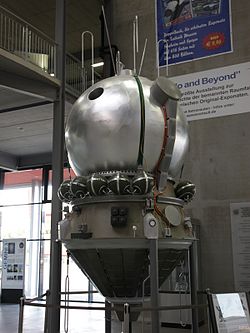STS-73
| STS-73 | |||||
 | |||||
| Uppdrag | ? | ||||
|---|---|---|---|---|---|
| Rymdfärja | Columbia (18)[1] | ||||
| NSSDC-ID | 1995-056A[2] | ||||
| Färdens tid | 15 dagar, 21 timmar, 53 minuter, 16 sekunder | ||||
| Uppskjutning | |||||
| Startplats | Startplatta 39B vid Kennedy Space Center i Florida | ||||
| Start | 20 oktober 1995, 9:53:00 a.m. EDT | ||||
| Landning | |||||
| Landningsplats | KSC Runway 33. | ||||
| Landning | 5 november 1995, 6:45:21 a.m. EST | ||||
| Omloppsbana | |||||
| Varv | 255 st[3] | ||||
| Apogeum | 241 km | ||||
| Perigeum | 241 km | ||||
| Banlutning | 39,0° | ||||
| Sträcka | 10,6 miljoner km | ||||
| Besättning | |||||
| Befälhavare | Kenneth D. Bowersox (3) | ||||
| Pilot | Kent Rominger (1) | ||||
| Uppdragsspecialister | Catherine G. Coleman (1) Michael López-Alegría (1) | ||||
| Nyttolastspecialister | Kathryn C. Thornton (4) Fred Weldon Leslie (1) Albert Sacco (1) | ||||
 | |||||
| Kronologi Rymdfärjeprogrammet | |||||
| |||||
STS-73 var en flygning i det amerikanska rymdfärjeprogrammet med rymdfärjan Columbia. Den sköts upp från Pad 39B vid Kennedy Space Center i Florida den 20 oktober 1995. Efter nästan sexton dagar i omloppsbana runt jorden återinträdde rymdfärjan i jordens atmosfär och landade vid Kennedy Space Center.
Se även
Referenser
- ^ NASA Space Shuttle Launch Archive Arkiverad 12 april 2012 hämtat från the Wayback Machine., läst 28 juli 2016.
- ^ ”NASA Space Science Data Coordinated Archive” (på engelska). NASA. https://nssdc.gsfc.nasa.gov/nmc/spacecraft/display.action?id=1995-056A. Läst 20 mars 2020.
- ^ Manned Astronautics - Figures & Facts Arkiverad 4 mars 2016 hämtat från the Wayback Machine., läst 28 juli 2016.
Externa länkar
 Wikimedia Commons har media som rör STS-73.
Wikimedia Commons har media som rör STS-73.
| ||||||||
| ||||||||||||||||||||||||||||||||
Media som används på denna webbplats
The crew patch of STS-73, the second flight of the United States Microgravity Laboratory (USML-2), depicts the Space Shuttle Columbia in the vastness of space. In the foreground are the classic regular polyhedrons that were investigated by Plato and later Euclid. The Pythagoreans were also fascinated by the symmetrical three-dimensional objects whose sides are the same regular polygon. The tetrahedron, the cube, the octahedron, and the icosahedron were each associated with the Natural Elements of that time: fire (on this mission represented as combustion science); Earth (crystallography), air and water (fluid physics). An additional icon shown as the infinity symbol was added to further convey the discipline of fluid mechanics. The shape of the emblem represents a fifth polyhedron, a dodecahedron, which the Pythagoreans thought corresponded to a fifth element that represented the cosmos.
STS-69 Mission Insignia
Författare/Upphovsman: Pascal (Flickr user: pasukaru76), Licens: CC0
Vostok spacecraft replica at the Technik Museum Speyer, Germany.
STS-74 Mission Insignia
- The STS-74 crew patch depicts the orbiter Atlantis docked to the Russian Space Station Mir. The central focus is on the Russian-built docking module, drawn with shading to accentuate its pivotal importance to both STS-74 and the NASA-Mir Program. The rainbow across the horizon represents the Earth's atmosphere, the thin membrane protecting all nations, while the three flags across the bottom show those nations participating in STS-74: Russia, Canada, and the United States. The sunrise is symbolic of the dawn of a new era in NASA space flight , that of International Space Station construction.
Crew of the Space Shuttle mission STS-73. NASA photo STS073-S-002 taken July 1995. :On the front row, left to right, are Albert Sacco Jr., payload specialist; Kent V. Rominger, pilot; Michael E. Lopez-Alegria, mission specialist. On the back row are, left to right, Catherine G. Coleman, mission specialist; Kenneth D. Bowersox, commander; Fred W. Leslie, payload specialist; and Kathryn C. Thornton, payload commander.







